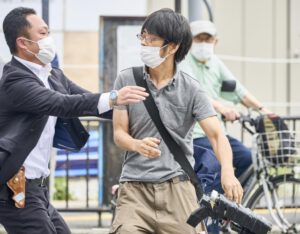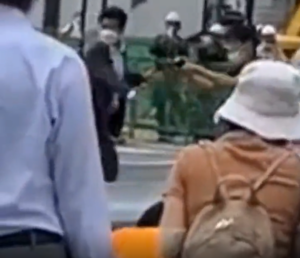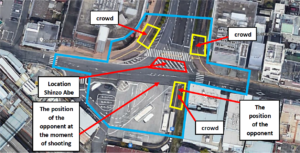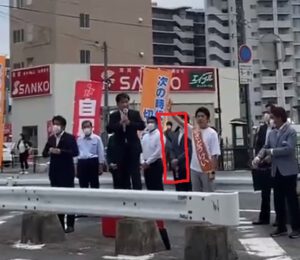Article author: Miky Weinberg – Owner of the Tarantula Technologies Ltd and Octagon Security Ltd Companies.
On Friday, July 8, 2022, reports began to arrive from Japan of an assassination attempt on former Japanese Prime Minister Mr. Shinzo Abe during a speech he/she delivered at an open election rally in the western city of Nara, near the Yamoto Saidaiji train station. Shortly afterward, videos begin to show up on the Internet that managed to document the moments of the assassination – one assassin, a 41-year-old Japanese citizen who served in the Japanese navy, with one improvised weapon, fired two bullets at a distance of about 5 meters at the back of former Prime Minister Shinzo Abe. The second bullet struck and wounded Shinzo Abe at a fatal level. A short time after he/she was taken to hospital, former Japanese Prime Minister Mr. Shinzo Abe died of his wounds.
Assessment regarding the motive of the assassin Tsuya Yamagami was that Yamagami believed that the former prime minister had a connection to the Unification Church, which is located in South Korea and is also active in Japan.
Close protection in general and the Japanese close protection unit in particular once again experienced failure in dealing with one adversary with one gun emerging behind the principal and succeeding in firing accurately before any of the close protection specialists in their sectors managed to prevent the attack, even though he/she was a former prime minister who continued to have close protection at events.
There is no doubt that the characteristics of the assassination of the former Prime Minister of Japan are reminiscent of the characteristics of the assassination of the Israeli Prime Minister Yitzhak Rabin 26 years ago.
Picture of the assassin with the improvised weapon (it appears to be an improvised weapon with ammunition of a shotgun, which is easy to obtain in Japan, or a muzzleloader, with gunpowder, standard or improvised and a suitable bullet):

Once again the obvious question is: how can a professional and skilled close protection unit fail to prevent injury to the principal?
The uniqueness of close protection:
History shows that most of the assassination attempts on personalities around the world were carried out by one or more adversaries, with a personal or political motive, who had the ability, daring, and courage who simply decided to try and succeed despite the presence of close protection specialists around the principal. In addition, factually, most of the adversaries succeeded in the assassination mission in incidents in which the close protection unit allowed the public to stand close to the principal without undergoing a security screening (such as in the attempted assassination of US President Ronald Reagan, the assassination attempt on Israeli Prime Minister Yitzhak Rabin and more).
The object of security in close protection is a flesh and blood person who can be injured at various levels and even reach a state of death from which there is no way back therefore the price of error in close protection is several times higher than the price of error in other security fields.
The adversary in close protection acts out of a strong motive, learns about the level of security around the principal, decides on the course of action for the assassination, the date and place, and how far he/she is willing to go to succeed in harming and even killing the target – the principal.
The uniqueness in the field of close protection is the fact that the security of the principal is dynamic and that the close protection specialist can never know whether all the security operations they perform daily do indeed keep potential rivals away from the principal, and despite this, he/she must continue to maintain security daily anew looking after the next adversary. Every close protection unit in the world must believe that at some point a new adversary may arise who dares to confront the close protection specialists in an attempt to harm the principal in the way and means he/she or she decides while exploiting mistakes in the perception and security methodology and/or level and quality of security in the field that is presented by the security array.
In close protection, if the security array allows the adversary to reach the state of carrying out the attack, whether, by firearms or other means of attack, the chance of succeeding in preventing actual personal injury becomes low, and it does not depend on the array and any active action against the adversary will start with failure.
Picture of the moment of shooting at the principal:

The Japanese Personnel Security Unit has failed in its mission to secure its security object, former Prime Minister Mr. Shinzo Abe, during its participation in an open election event – I sincerely hope that this unit will overcome the severe sense of failure and move towards a better future.
The belief among the security forces that an adversary can actually arrive who will try to assassinate a person with a means of killing, including a firearm:
It is possible that the strict law in Japan on the right to bear a firearm with a license influenced the working assumptions in the security concept of the local close protection unit to the point that the chance of an assassin coming with a firearm is very small to impossible. If such a working assumption exists, it undoubtedly affects the security method applied by the security array that performs the various tasks under the responsibility of the unit – the close protection specialist in the field is focused more on dealing with an adversary with any non-firearm, including a pistol.
In the same way, the crime situation in Japan, which is considered one of the lowest in the world, can also affect the working assumptions that will determine that the chance of an attempted assassination attempt in Japan tends to be zero.
Note: Japan is considered an unparalleled safe country, one where citizens and tourists can roam around without fear for their lives or property. One reason for this is the tough policy on firearms possession. Japanese law prohibits, almost universally, the possession of firearms. Under Japanese law, the possession of a firearm is generally allowed only by formal agencies, such as the police and defense forces. Another group that is allowed to possess weapons is the hunters, whose law allows them to issue a rifle license only.
Such a law could cause the potential adversary to find other ways to obtain weapons, including making improvised weapons as the assassin did in the assassination of Shinzo Abe.
Picture of the improvised weapon used by the assassin:

The data on the level of principal security at the event can be extracted from the photographed documentation:
The Japanese close protection unit secured the principal based on the security plan in an open-air event with an audience.
The program included a decision on the location of the principal at the event and the location of the audience.
The road does not appear to be closed to vehicular traffic during the incident – vehicles are seen traveling during the principal’s speech.
The security array included several rings – close protection specialists, close protection specialists in the perimeter area for the location of the principal and police officers.
The audience at the event is located at several points and a distance of several meters from the location of the principal.
Some of the close protection specialists appear to be armed with a pistol.
It seems that at least 2 close protection specialists have in their hands a mobile device to protect the principal against a bullet hit.
It is not clear whether a security check process was conducted for the audience at the incident.
It seems that the principal did not wear a protective vest.
The backspace for the principal seems to be closed to visits by crowds.
The assassinating adversary was photographed standing with a side bag in the crowd group placed at the back right for the location of the principal.
The adversary was recorded going down the road, advancing towards the principal as he/she took out the improvised weapon, straightened his arms, and fired two bullets from a distance of about 5 meters.
The assassin’s adversary appears to have fired the first bullet and then a second.
According to the principal’s reaction, it seems that the first bullet did not hit him/her and the second bullet did hit and knocked him/her to the ground injured.
Just before the shooting, it appears that the close protection specialist who was in the back area to the location of the principal noticed the assassinating adversary but did not take any effective counter-measures that managed to prevent him/her from firing at the principal.
It seems that the close protection specialists next to the principal did not take any active action to bring the principal to the ground after hearing the first bullet fire.
It seems that the close protection specialist who was holding the mobile device against bullets did not have time to use it fully and effectively.
After firing the two bullets, one of the close protection specialists is seen jumping on the assassinating adversary who at this point drops the improvised weapon to the floor.
No close protection specialist was seen pulling out a gun at any point when the shooting began.
Aerial photo of the location of the incident and the security plan:

The assassinated adversary as documented stands in the audience:

Documentation of the assassinating adversary shooting:
How to deal with an assassinating adversary during a security event in an open field event:
Secure the principal based on a dedicated security plan for the event that includes an analysis of the attacker’s viewpoint, a list of relevant threats, and a list of responses to the threats.
Demarcation of the event area and its closure for vehicle entry.
Determining the location of the principal at the event.
Determining the location of the audience at the event and demarcating it with a fence – at a distance that will allow the audience to see and hear the principal and will make it difficult for the audience to approach him/her without the security force noticing.
Carrying out a security inspection process for the public to locate weapons on the body and/or baggage.
Deployment of close protection specialists in security rings: close ring, peripheral ring, and close protection specialists in positions in front of the audience.
Deployment of auxiliary forces, and police, mainly in the crowd complexes and roadblocks.
Performing actions to locate the adversary in the prevention phase – while he/she is in the crowd.
Use of protective equipment against shooting damage, such as a protective vest for the principal, placement of a reinforced glass wall in the scope of the principal’s location in accordance with professional analysis, or placement of at least 2 close protection specialists to close the principal back and use a mobile device to absorb bullets.
Active protection action of the close protection specialist placed in the back area for the principal from the moment the adversary is identified pulls out the gun and straightens the hands into firing position.
Proper work of the circle close to the principal from the moment the first shooting noise is heard by putting the principal on the ground quickly.
In conclusion:
It is no coincidence that we see close protection units that have experienced a failure in a close protection mission, such as the American close protection unit and the Israeli close protection unit, which have since invested a lot of resources and effort in learning about their potential adversary and preventive plan. Looking at it from the side, the level of security performed by the above units may seem excessive and unreasonable but for those in charge of the principal security task this is the level required not to be caught again unprepared to face the assassinate quarrel, this is all in order not to experience it again.
My heart goes out to the Japanese close protection unit that yesterday experienced the biggest failure that can be experienced in the field of close protection and in the hope that they will learn from the lessons of failure to get better and become a better unit.
Remember, “security must be maintained” by constantly thinking about the adversary !!!